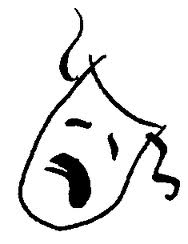Australian Town Crier - Norman Ness
I have read with interest the fractured versions of the origins of town criers, however I would now like to share with you all the real story……
The first town crier was of course an Australian.
Norman Ness, the first born son or Sacks Ness and Mary Ness. He was appointed to bring news of the happenings in the small hamlet of Ire which is somewhere in Queensland. As he approached the town square to deliver history’s first proclamation, he started to speak. He was distracted by the mutterings of some small children to his right. As Norman called out “Who’s That”, the small children mocked and mimicked him replying “Who’s That”. This great amusement pleased the gathered crowd and Norman commenced all of his proclamations with the calls of “Who’s That”.
Norman was an orator, an adventurer and a warrior. He left Ire to discover the world in his very own hand carved canoe and made his way to the land now known as the United Kingdom.
Norman was bigger, stronger and far better looking than any of the inhabitants that he encountered and he impressed them all with his fine proclamations and fighting ability. He would start his calls with “Who’s That” and the crowd, having difficulty with his superior accent would reply with “Oyez”. This reply stuck and is used by Town criers all over the world today.
The people of this land were so impressed, that their leader approached Norman and asked him as to his heritage. When Norman replied “I am Sacks son” the leader replied “Then we are all Sacks son”. Thus the birth of the Saxon nation.
Famine and hunger struck the land and rumours from the north were of giant pigs, large enough to each feed 10000 people. Norman proclaimed that he would lead the Saxons to capture these beasts and herd them south to feed his people. Following a successful hunt, ceremonies were arranged and the largest of the beasts were carved up and sent to the far reaching communities. The left forequarter headed west to town now known as West Ham. The right forequarter went north to a town now known as Northampton. The under belly that was charred travelled to a town that was then called Burnt in Ham, later known as Birmingham. The rear part of the pig was sent to a place named Arsenal.
A tender piece was sent to another town and Norman was invited to share the feast. The feast was laid out in fine splendour and the villagers awaited for Norman to join them. When he did arrive the crowd, in one voice called, “we have waited for you, and there has been None Eaten. From this time the land was called Noneeaten. Norman appointed a town crier to this village, however he was of poor quality. In fact, all town criers since appointed to the borough of Nuneaten have been of little significance.
Norman was a very adept sportsman, particularly at the game of football. He could balance a ball on his foot, his head and his chest. His prowess of the latter gave birth to the cities now known as Chester and Manchester.
His next journey was across to mainland Europe where he was greeted by the inhabitants with great joy. They were jealous that they could not call themselves the same as those across the channel, so they settled for the name Norman. This was the birth of The Norman Empire.
On his trip back towards his original homeland he passed through Spain where his fine masculine Australian features caught the eye of a young Queen in Aragon. Their love tussle produced a daughter named Catherine who later went on to become one of the wives of Henry VIII.
When the Spanish King learnt of his Queens dalliances, he had Norman beheaded. His body was buried on a small island off the coast of England which was renamed Ire-land after his hometown. His head was taken north for a traditional Saxon ceremony, however it slipped off the horse and cart and rolled into a wee loch. The loch was later named in his honour being Loch Ness and it is said his ghost is often seen rising up out of the water.
Every two years England and Australia celebrate the memory of Norman. 11 Australians calling “Who’s that” on some 20 occasions, highlight the five-day long celebrations. Unfortunately recent history has shown that the English can only extend the celebrations out to three and a half days but we love them still. Very still.
So, I hope this sets the record straight. The Australians are the pioneers of Town Criers, the term Oyez, The Saxons, The Normans, Ireland, Loch Ness and its monster, several English place names, Football and the monarchy.
One of the greatest fans of Norman Ness is Queen Elizabeth II of Australia. We Australians appreciate that our English friends also share an appreciation of Australia’s Queen.
